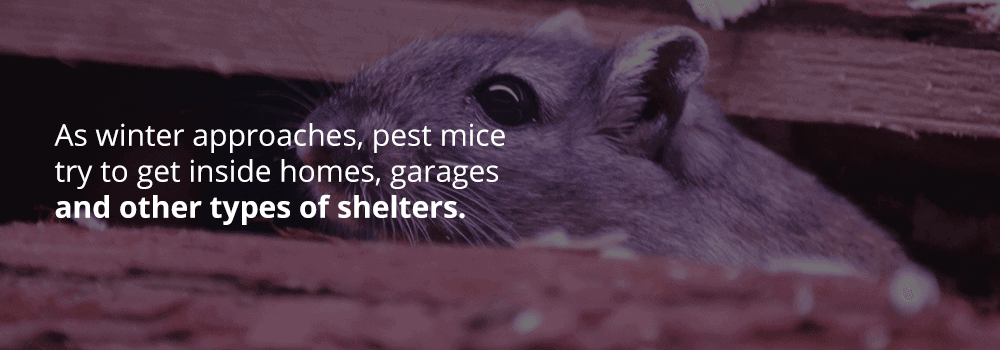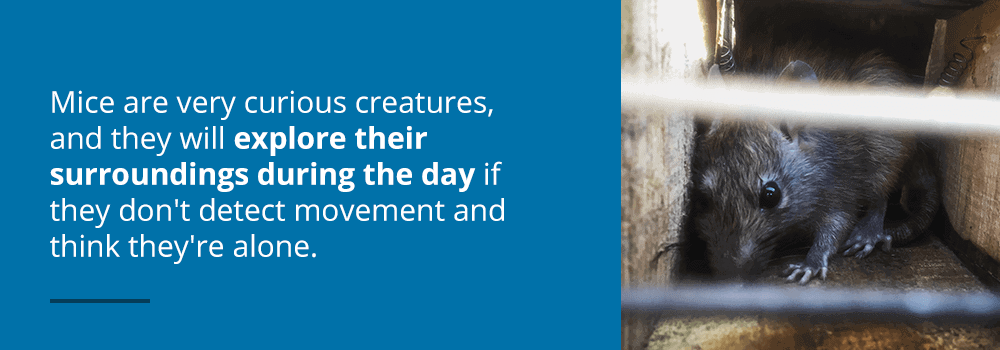Chapter 1: Mouse Identification

If you’ve found a mouse in your home or business, it’s likely a house mouse. House mice are the most common mammal in the world and the most common type of mouse to invade a home. They are highly adaptable and resilient creatures and have been found living in various environments from English coal mines to South American deserts. According to the Maryland Department of Agriculture, house mice have even been found living on an island near Antarctica.
Native to Asia, house mice came to North America with the arrival of European settlers. Now you can find house mice in every state.
If you’re not sure if you have a mouse guest or some other pest type, we’re ready to help. In this chapter, we’ll show you how to identify a mouse and discover its hideout.
Types of Pest Mice
As mentioned, the house mouse is the most common type of mouse to infest a home. House mice happily snack on human or pet food and thrive in various conditions. Other types of mice known to invade North American structures include:
- Deer mice: Deer mice are more common in rural or semi-rural areas. Like white-tailed deer, deer mice have white fur on their bellies and gray or brown fur on the top. You can find deer mice in many habitats across North America, from grasslands to forests.
- White-footed mice: White-footed mice are a close relative of deer mice and have a similar appearance. Like deer mice, they live in a range of habitats but prefer wooded or brushy areas.
Both the deer mouse and white-footed mouse are native to North America, and they are about the same size as the house mouse. All three types of mice do not hibernate and stay active in the winter, seeking food and shelter. As winter approaches, pest mice try to get inside homes, garages and other types of shelters.
To tell them apart, deer mice and white-footed mice have larger eyes than house mice. They also have white bellies, whereas house mice have a solid gray or light brown coat color. Deer mice and white-footed mice share similar physical capabilities with house mice, meaning they can climb, run through the dark and squeeze through tiny holes.
Pest Mice and Hantaviruses
Although deer mice and white-footed mice mostly nest outdoors, you’ll still want to take action if you find these rodents in your house. Deer mice and white-footed mice are known to carry hantaviruses. Not every deer mouse or white-footed mouse is infected with hantavirus, but it’s hard to tell which ones are.
Certain hantaviruses can cause hantavirus pulmonary syndrome (HPS), a severe respiratory disease. The Centers for Disease Control and Prevention report that HPS is rare, but it has occurred everywhere in the United States except for Alaska and Hawaii. You can get hantavirus by breathing in virus particles from mouse urine or droppings. You can also get it by touching nesting materials, urine or feces and then touching your nose or mouth. To be safe, always address a mouse problem immediately, no matter what type of mouse is in your home.
How to Identify a Mouse
It can be tricky to identify a mouse because of how fast they zip across the floor. However, if you catch a glimpse of the speedy creature, look for the following traits to determine if it’s a mouse or another rodent:
- Large ears and small head
- Small, black eyes
- Triangular snout
- Thin tail with sparse or short hairs
- Small body of about 6 inches long, including the tail
- Brown, grey, black or white coat
Since mice have poor eyesight, they use their whiskers to navigate and usually travel along walls. So, if you’re looking for mice in your home, expect to find them scurrying from one point to the next close to the wall.
Where Do Mice Live?
In general, mice live in nests made of soft, light materials such as plants, paper, string, fabric and insulation. Nests are usually about 4 inches across. Mice are very adaptable and resourceful and will build a nest anywhere hidden and near a food source.
Outdoors, house mice live in burrows, tree hollows, logs, weeds, debris piles or cracks in walls or rocks. Deer mice and white-footed mice prefer to build nests around tree roots, inside tree stumps, under logs or in woodpiles.
Inside a home, house mice, deer mice and white-footed mice have the same nest-building preferences. Mice may live in the walls, under or inside appliances or furniture, under cabinets or in crawl spaces or storage boxes.
As long as mice have access to food, they will not travel more than 50 feet from their nest. Therefore, if you find a mouse in your home, their nest likely isn’t too far away. Mice have an excellent memory, memorizing pathways, obstacles, food sources and shelters in their territory.
Are Mice Nocturnal?
Yes, mice are generally nocturnal and rarely seen by a homeowner. This means they prefer to sleep during the day and forage for food at night. However, mice are very curious creatures, and they will explore their surroundings during the day if they don’t detect movement and think they’re alone. You may also see mice in the daytime if you have a heavy infestation, and the rodents are running out of places to hide.

Where Do Mice Hide During the Day?
Mice hide wherever they can find a secret shelter, including very tiny areas. They might take cover in walls, cabinets, cluttered corners or any tight spot they can dodge into, usually not too far away from their nest. A mouse typically spends its entire life within a 20-foot radius of its nest.
Where Do Mice Hide in Stoves?
Mice might have nests behind or underneath a stove. They might also hide in the insulation of a stove. If mice have nested in your stove, they may have also chewed through the wiring. In such a case, it’s probably best to replace the stove with a new one and take steps to prevent mice from coming into your home.
Do Mice Hide in Clothes?
Since mice prefer secret spots and like soft, cozy materials, they can hide in piles of old clothes or storage boxes containing clothes.
Will a Mouse Crawl on You While You’re Sleeping?
Mice are good climbers, and they can jump as high as 12 inches, so they could crawl on you while you sleep. However, it’s not likely they will want to climb into your bed unless they smell food and are desperate for something to eat. Luckily, mice would prefer to avoid human contact.
How Do You Know If You Have a Mouse Infestation?
You might never see an actual mouse unless you have a severe infestation, so you’ll have to look for other signs, such as droppings in a kitchen drawer or food packages with gnaw marks. In the next chapter, we’ll show you more signs to look for during your mouse investigation.
If you’ve found evidence of a mouse infestation or want to learn more, we’re here to help at Pestech Pest Solutions.

